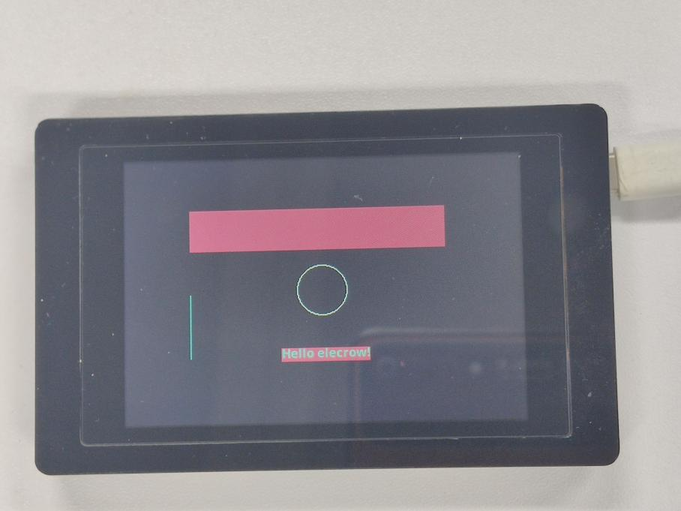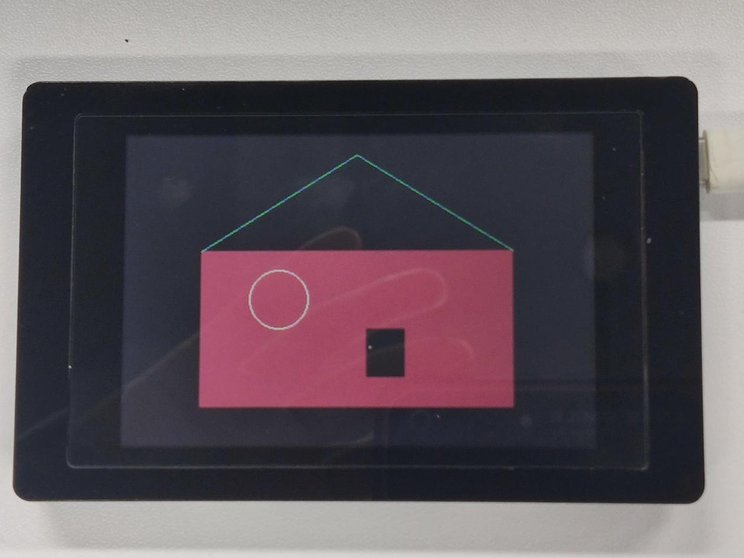Lesson02 Start the ESP32 DISPLAY GUI drawing via LovyanGFX Graphics Library
Project Introduction:¶
Using Arduino programming and the graphics library functions, draw different patterns and combine them into a complete clock work.
Introduction to Knowledge Points:¶
LovyanGFX Library:
LovyanGFX is a high-performance graphics library based on the Adafruit-GFX-Library that can run on many hardware platforms such as ESP32, ESP8266, STM32, etc. LovyanGFX aims to provide fast, flexible, and easy-to-use tools for drawing high-quality graphics in graphical user interfaces and graphics applications. It supports pixel-level operations, 68 billion colors, multiple fonts, image loading, and many other features. It also includes a powerful graphics engine that can provide efficient performance in a variety of situations. Therefore, LovyanGFX can help users quickly create high-quality graphics applications and user interfaces while maintaining good performance and compatibility.
Basic Functions of LovyanGFX Library:
| Basic Function | Overview | Prototype | Parameter Descripition |
|---|---|---|---|
| createSprite() | The createSprite() function is used in the LovyanGFX library to create graphic sprites. Before drawing patterns, the screen size needs to be configured. | LGFX_Sprite createSprite(int16_t w, int16_t h); | w: the width of the sprite. h: the height of the sprite. Return value: an object of type LGFX_Sprite, representing the created graphic sprite. |
| fillRect() | The fillRect() function is used in the LovyanGFX library to draw rectangles. | void fillRect(int32_t x, int32_t y, int32_t w, int32_t h, uint32_t color); | x, y: the coordinates of the upper-left corner of the rectangle. w, h: the width and height of the rectangle. color: the fill color. It can be an RGB888 format color value or an RGB565 format color value. |
| drawLine() | The drawLine() function is used in the LovyanGFX library to draw straight lines. | void drawLine(int32_t x0, int32_t y0, int32_t x1, int32_t y1, uint32_t color); | x0, y0: the starting coordinates of the line. x1, y1: the ending coordinates of the line. color: the color of the line. It can be an RGB888 format color value or an RGB565 format color value. |
| drawCircle() | The drawCircle() function is used in the LovyanGFX library to draw circles. | void drawCircle(int32_t x, int32_t y, int32_t r, uint32_t color); | x, y: the coordinates of the center of the circle. r: the radius of the circle. color: the color of the circle. It can be an RGB888 format color value or an RGB565 format color value. |
| loadFont() | The loadFont() function is used in the LovyanGFX library to load small fonts. | void loadFont(small); | small: the type of small font to be loaded. |
| setTextColor() | The setTextColor() function is used in the LovyanGFX library to set the text and background colors. | void setTextColor(uint32_t color1, uint32_t color2); | Color1: the color of the text. It can be an RGB888 format color value or an RGB565 format color value. Color2: the color of the background. It can be an RGB888 format color value or an RGB565 format color value. |
| drawString() | The drawString() function is used in the LovyanGFX library to draw strings. | void drawString(const char* str, int32_t x, int32_t y); | str: the string to be drawn. x, y: the coordinates of the lower-left corner of the string. |
| pushSprite() | The pushSprite() function is used in the LovyanGFX library to draw graphic sprites on the screen. After drawing the pattern, this function needs to be called. | void pushSprite(int32_t x, int32_t y); | x: the horizontal coordinate of the sprite on the screen. y: the vertical coordinate of the sprite on the screen. |
Usage: Call the begin() function in the setup() function to initialize the screen and LovyanGFX library.
In the loop() function, first call the createSprite() function to create a graphic sprite, then use functions such as fillRect(), drawLine(), drawCircle(), loadFont(), setTextColor(), and drawString() to draw patterns and text, and finally use the pushSprite() function to draw the graphic sprite on the screen. The specific implementation needs to be written based on the specific clock design.
Sample program:¶
According to the usage of the library functions introduced above, we write a program to display related patterns: Take the esp32 3.5inch rgb terminal screen as an example.
Please download lesson02-1.zip
//Contains LovyanGFX library and related font library
#include "rgbdisplay.h"
#include "Latin_Hiragana_24.h"
#include "NotoSansBold15.h"
#include "NotoSansMonoSCB20.h"
//define font
#define latin Latin_Hiragana_24
#define small NotoSansBold15
#define digits NotoSansMonoSCB20
//define color
#define c1 0xE73C //white
#define c2 0x18C3 //gray
#define c3 0x9986 //red
#define c4 0x2CAB //green
#define c5 0xBDEF //gold
#define c6 0xFFFAFA //snow
//Settings for initializing the program
void setup() {
pinMode(LCD_CS, OUTPUT);//sets the pin mode for the LCD chip select (CS) pin to output mode. This pin is likely used to enable communication with the display.<br>
pinMode(LCD_BLK, OUTPUT);//sets the pin mode for the LCD backlight (BLK) pin to output mode. This pin is likely used to control the display's backlight.<br>
digitalWrite(LCD_CS, LOW);//sets the CS pin to low, likely to enable communication with the display.<br>
digitalWrite(LCD_BLK, HIGH);//sets the BLK pin to high, likely to turn on the display's backlight.<br>
lcd.init();//initializes the display library.<br>
lcd.setRotation(1);//sets the display rotation to 1, likely to rotate the display 90 degrees.<br>
lcd.fillScreen(TFT_WHITE);//fills the display screen with white color.<br>
sprite.createSprite(480,320);//creates a sprite object with a width of 480 pixels and a height of 320 pixels. This sprite is likely used to draw graphics or images on the display.<br>
}
void loop()
{
//draw graphics
sprite.fillRect(80,61,310,50,0x9986);//draw a rectangle
sprite.drawLine(80,164,80,240,0x2CAB);//draw a line
sprite.loadFont(small);
sprite.setTextColor(c4,c3);
sprite.drawString("Hello elecrow!",190,230);//write a paragraph
sprite.drawCircle(240, 160, 30, c5);//draw a circle
sprite.pushSprite(0,0);
}
Expansion:¶
According to the functions learned earlier, draw a graph, here draw a small house.
Please download lesson02-2.zip
#include "rgbdisplay.h"
#include "Latin_Hiragana_24.h"
#include "NotoSansBold15.h"
#include "NotoSansMonoSCB20.h"
#define latin Latin_Hiragana_24
#define small NotoSansBold15
#define digits NotoSansMonoSCB20
#define c1 0xE73C //white
#define c2 0x18C3 //gray
#define c3 0x9986 //red
#define c4 0x2CAB //green
#define c5 0xBDEF //gold
#define c6 0xFFFAFA //snow
void setup() {
pinMode(LCD_CS, OUTPUT);
pinMode(LCD_BLK, OUTPUT);
digitalWrite(LCD_CS, LOW);
digitalWrite(LCD_BLK, HIGH);
lcd.init();
lcd.setRotation(1);
lcd.fillScreen(TFT_WHITE);
sprite.createSprite(480,320);
}
void loop()
{
sprite.fillRect(80,120,320,160,0x9986);
sprite.fillRect(250,200,40,50,c2);
sprite.drawLine(80,120,240,20,0x2CAB);
sprite.drawLine(240,20,400,120,0x2CAB);
sprite.drawCircle(160, 170, 30, c5);
sprite.pushSprite(0,0);
}
HMI Display Tutorial Contents¶
- Lesson01 Introducing the ESP32 Display series and environment configuration
- Lesson02 Start the ESP32 DISPLAY GUI drawing via LovyanGFX Graphics Library
- Lesson03 How to Display Pictures on ESP32 Boards
- Lesson04 LVGL Basics: How to install LVGL for ESP32 Displays
- Lesson05 Introduction to the 5 categories of LVGL GUI library Widgets
- Lesson06 Use Squareline Studio to start your 1st human machine interface project
- Lesson07 How to implement text information input with Squareline Studio
- Lesson08 How to make the menu and a progress bar with Squareline Studio
- Lesson09 How to make an analysis report on ESP32 Display
- Lesson10 Create a 3D Printer UI Project on ESP32 Display
- Lesson11 How to Make a Mixer Interface on ESP32 Display
- Lesson12 Make Your ESP32 Display the Lantern Control terminal
- Lesson13 DIY Electronic Control Terminal on ESP32 Display with Squareline Studio
- Lesson14 Create Car Control Screen on ESP32 Display: A Step-by-Step Guide
- Lesson15 Smart Agriculture Monitoring: IoT-Based Real-Time ESP32 Display Project
- Lesson16 ESP32 Display for Smart Home Central Control: A Home Automation Solution

